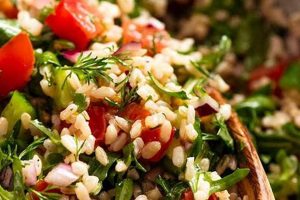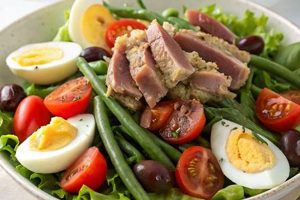A dish composed of peppery arugula, sweet pears, and other complementary ingredients, often including cheese, nuts, and a vinaigrette, exemplifies a simple yet sophisticated culinary creation. Variations may incorporate ingredients such as dried cranberries, crumbled bacon, or toasted walnuts, offering a range of flavor profiles from sweet and savory to tangy and spicy. For example, a combination of arugula, sliced pear, gorgonzola cheese, candied pecans, and a balsamic vinaigrette creates a balanced and flavorful salad.
This type of salad offers nutritional benefits due to the vitamins and minerals present in the leafy greens and fruit. Arugula provides vitamins A, C, and K, while pears contribute fiber and antioxidants. Furthermore, the inclusion of nuts and cheese adds healthy fats and protein. The customizable nature of such salads allows for adjustments to cater to dietary restrictions and preferences. From a culinary perspective, the contrasting textures and flavors create a dynamic sensory experience. The slight bitterness of the greens, the sweetness of the fruit, and the richness of the added components combine to form a well-rounded dish, suitable as a light meal or a side dish.
This exploration of the elements involved will delve into variations, ingredient selection, dressing options, and techniques for creating balanced flavor profiles. Further discussion will address the nutritional value and the role of this salad type in a healthy diet. Finally, practical guidance, including tips and step-by-step instructions, will equip readers to create their own versions.
Tips for Crafting the Perfect Arugula and Pear Salad
Creating a well-balanced and flavorful salad involves careful consideration of ingredient selection, preparation techniques, and dressing choices.
Tip 1: Ingredient Quality is Paramount: Opt for fresh, crisp arugula and ripe, but firm, pears. The quality of ingredients directly impacts the final flavor profile.
Tip 2: Balance Flavors and Textures: Consider incorporating ingredients with contrasting textures and flavors, such as crunchy nuts, creamy cheese, and a tangy vinaigrette, to create a multi-dimensional culinary experience.
Tip 3: Proper Pear Preparation: Prevent browning by lightly coating sliced pears with lemon juice. This helps maintain both their appearance and fresh taste.
Tip 4: Strategic Ingredient Incorporation: Add delicate ingredients, like toasted nuts or crumbled cheese, just before serving to maintain their texture and prevent them from becoming soggy.
Tip 5: Dressing Application: Lightly dress the salad to avoid wilting the arugula. Toss gently to ensure even coating.
Tip 6: Explore Varietal Pears: Experiment with different pear varieties, such as Bosc, Anjou, or Bartlett, to discover unique flavor nuances.
Tip 7: Temperature Considerations: Serve the salad slightly chilled. This enhances the crispness of the arugula and the refreshing qualities of the pear.
By adhering to these guidelines, one can elevate a simple salad into a refined culinary creation, maximizing both flavor and presentation.
These practical tips provide a foundation for creating a delightful culinary experience. The following section will offer concluding remarks and suggest further exploration of this versatile dish.
1. Arugula
Arugula serves as the foundational leafy green in an arugula pear salad recipe, contributing a distinctive peppery flavor and vibrant green texture. Understanding its characteristics and culinary applications is crucial for creating a successful and balanced salad.
- Flavor Profile
Arugula’s signature peppery, slightly bitter taste offers a counterpoint to the sweetness of the pear. This contrast creates a dynamic flavor profile that distinguishes the salad from those using milder greens. The intensity of the peppery flavor can vary depending on the arugula’s maturity and growing conditions.
- Textural Contribution
Arugula’s tender yet slightly coarse leaves provide textural complexity. The leaves hold their shape well, preventing the salad from becoming soggy while offering a pleasant chewiness. This textural element complements the smooth texture of the pear and other potential ingredients.
- Nutritional Value
Beyond flavor and texture, arugula contributes nutritional value, rich in vitamins A, C, and K, as well as minerals like calcium and potassium. These nutrients enhance the overall health benefits of the salad, making it a nutritious and flavorful choice.
- Culinary Versatility
Arugula’s robust flavor profile allows it to stand up to bold ingredients like strong cheeses, nuts, and acidic dressings. This versatility makes it an ideal base for salads featuring diverse flavors and textures, expanding the potential recipe variations. For instance, its peppery taste pairs well with the saltiness of Parmesan cheese and the sweetness of balsamic vinegar.
The interplay of arugula’s distinct flavor, texture, and nutritional value establishes it as a key component of an arugula pear salad recipe. Its versatility allows for diverse ingredient pairings, creating a balanced and flavorful culinary experience. Careful selection and preparation of the arugula contribute significantly to the overall success of the dish.
2. Pear Varieties
Pear variety selection significantly influences the flavor profile, texture, and overall balance of an arugula pear salad recipe. Different pear cultivars offer unique characteristics, impacting the interplay of sweetness, acidity, and firmness within the salad.
- Bartlett Pears
Bartlett pears, known for their soft, juicy texture and classic sweet flavor, contribute a delicate sweetness to the salad. Their delicate texture, however, may require careful handling to prevent bruising during preparation. This variety pairs well with milder cheeses and lighter vinaigrettes.
- Bosc Pears
Bosc pears offer a firm, dense texture and a subtly sweet, slightly spicy flavor. Their firmness holds up well in salads, maintaining their shape and providing a pleasant textural contrast to the arugula. Bosc pears complement bolder cheeses like gorgonzola or Roquefort and pair well with balsamic or walnut vinaigrettes.
- Anjou Pears
Anjou pears, available in both red and green varieties, possess a mild, sweet flavor and a firm texture. Their versatility allows them to complement a wide range of ingredients, from creamy cheeses to candied nuts. Anjou pears work well with both light and robust vinaigrettes.
- Comice Pears
Comice pears, known for their buttery texture and delicate, sweet flavor, offer a luxurious element to the salad. Their delicate nature requires careful handling. Comice pears pair well with milder cheeses and light vinaigrettes, emphasizing their inherent sweetness.
The chosen pear variety contributes significantly to the overall sensory experience of the arugula pear salad. Careful consideration of flavor profiles, textures, and complementary ingredients allows for a tailored culinary creation. The right pear can elevate this simple salad into a sophisticated dish.
3. Complementary Ingredients
Complementary ingredients elevate an arugula pear salad recipe from simple to sophisticated. Strategic ingredient selection enhances flavor complexity, textural contrast, and nutritional value, transforming the salad into a well-rounded culinary experience.
- Cheese
Cheese contributes creamy texture and salty, savory notes. Options range from pungent blue cheese and crumbly gorgonzola to nutty Parmesan and tangy feta. Selection depends on the desired intensity and interplay with other ingredients. For instance, a strong blue cheese contrasts the sweet pear, while a milder feta complements a light vinaigrette. The cheese choice significantly impacts the overall flavor profile.
- Nuts
Nuts provide crunchy texture and earthy, rich flavors. Toasted walnuts, pecans, or almonds add depth and complexity. Candied nuts introduce sweetness and textural variation. The nut selection influences both the flavor and textural dimensions of the salad. Toasted pecans complement the sweetness of pears, while candied walnuts offer a contrasting sweetness and crunch.
- Dried Fruit
Dried fruit offers chewy texture and concentrated sweetness. Cranberries, raisins, or chopped dates enhance the flavor profile and provide textural contrast. Dried cranberries offer tartness, balancing the sweetness of pears, while chopped dates provide a caramel-like sweetness. The choice of dried fruit contributes to both the flavor and texture balance.
- Other additions
Further additions enhance flavor and visual appeal. Caramelized onions offer sweetness and depth, while roasted vegetables, such as butternut squash or beets, introduce earthy notes and vibrant color. Protein elements, such as grilled chicken or chickpeas, contribute nutritional value and heartiness. These additions transform the salad into a more substantial and complex dish. For instance, grilled chicken adds protein, while roasted butternut squash contributes sweetness and color.
Careful consideration of complementary ingredients elevates the arugula pear salad recipe. The interplay of flavors, textures, and colors creates a dynamic and satisfying culinary experience. Strategic ingredient selection ensures a well-balanced and nuanced salad, offering both visual appeal and nutritional value.
4. Dressing Selection
Dressing selection significantly impacts the overall balance and flavor profile of an arugula pear salad recipe. The dressing acts as a unifying element, harmonizing the diverse flavors and textures of the ingredients. A well-chosen dressing enhances the inherent qualities of the arugula and pear, while a poorly suited dressing can overwhelm or clash with these core components.
The interplay between acidity, sweetness, and richness within the dressing is crucial. A vinaigrette with high acidity, such as a classic lemon vinaigrette, cuts through the richness of cheese and complements the peppery arugula. A balsamic vinaigrette, with its sweet and tangy notes, balances the sweetness of the pear and enhances the earthiness of nuts. A creamy dressing, such as one based on yogurt or buttermilk, provides a contrasting texture and milder flavor, allowing the other ingredients to shine. For instance, a salad with gorgonzola cheese and candied walnuts benefits from a balsamic vinaigrette, while a salad with feta cheese and dried cranberries might pair well with a lemon vinaigrette. Consideration should be given to the intensity of the dressing relative to the other ingredients. A delicate pear flavor can be overwhelmed by a robust dressing, while a peppery arugula can stand up to a more assertive vinaigrette.
Careful dressing selection is essential for a successful arugula pear salad recipe. The dressing should complement and enhance, not mask, the flavors of the other ingredients. Understanding the interplay of acidity, sweetness, and richness allows for informed choices that elevate the salad from simple to sophisticated. The ultimate goal is a harmonious balance of flavors and textures, creating a satisfying and memorable culinary experience.
5. Preparation Techniques
Preparation techniques significantly influence the final quality and enjoyment of an arugula pear salad recipe. Proper handling of ingredients, efficient workflow, and attention to detail elevate this seemingly simple dish. These techniques impact flavor, texture, presentation, and even food safety.
Ingredient Handling: Arugula requires gentle handling to avoid bruising. Washing and drying should be thorough but delicate. Pears, susceptible to enzymatic browning, benefit from immediate coating with an acidic element, such as lemon juice, after slicing. This preserves their appearance and prevents flavor degradation. Other ingredients, such as nuts, may require toasting to enhance their flavor and texture. Cheese should be stored and handled appropriately to maintain optimal quality. For example, delicate cheeses like gorgonzola should be added just before serving to prevent them from becoming overly soft.
Workflow Efficiency: Efficient workflow streamlines the preparation process, ensuring freshness and preventing delays. Organizing ingredients and equipment beforehand, known as mise en place, optimizes efficiency. Dressing preparation can be completed in advance. Having all components ready before assembly ensures a smooth and timely process, particularly important when serving multiple portions. This prevents the arugula from wilting and maintains the crispness of other elements.
Presentation: Visual appeal enhances the dining experience. Thoughtful arrangement of arugula, pear slices, and complementary ingredients on the serving platter elevates presentation. Consider color contrast and textural variation for an aesthetically pleasing result. A sprinkle of chopped nuts or a drizzle of balsamic glaze adds a finishing touch. Attractive presentation stimulates appetite and enhances perceived value.
Proper preparation techniques are essential for maximizing the quality and enjoyment of an arugula pear salad recipe. Careful ingredient handling, efficient workflow, and attention to presentation contribute to a superior culinary outcome. These techniques demonstrate a respect for ingredients and enhance the overall dining experience, transforming a simple salad into a sophisticated and satisfying dish.
Frequently Asked Questions
This section addresses common inquiries regarding the creation and enjoyment of arugula pear salads, offering concise and informative responses.
Question 1: How can enzymatic browning of pears be prevented after slicing?
Coating sliced pears with an acidic agent, such as lemon juice or ascorbic acid solution, inhibits enzymatic browning, preserving both appearance and flavor.
Question 2: What dressings complement the distinct flavors of arugula and pear?
Vinaigrettes with balanced acidity and sweetness, such as balsamic, lemon, or honey-mustard, enhance the peppery arugula and sweet pear without overpowering either flavor.
Question 3: Which pear varieties are best suited for salads?
Firmer varieties like Bosc or Anjou maintain their texture in salads. Bartlett pears, while delicious, require careful handling due to their softer texture.
Question 4: Can this salad be prepared in advance?
While components like the dressing can be prepared ahead, it is recommended to assemble the salad just before serving to prevent the arugula from wilting and maintain the crispness of other ingredients.
Question 5: What cheese varieties pair well with arugula and pear?
Blue cheese, gorgonzola, feta, and Parmesan all offer complementary flavor profiles, though selection depends on the desired intensity and balance within the salad.
Question 6: How can nutritional value be maximized in this salad?
Incorporating ingredients like nuts, seeds, and lean protein sources, such as grilled chicken or chickpeas, enhances the nutritional density of the salad.
Understanding these key aspects contributes to a more informed and successful culinary endeavor, ensuring a flavorful and enjoyable salad experience.
The subsequent section will offer a collection of curated recipes, providing practical examples and inspiration for creating diverse and delicious arugula pear salads.
Arugula Pear Salad Recipe
Exploration of the arugula pear salad recipe reveals a dish offering nuanced flavor profiles and versatile culinary applications. From the peppery bite of arugula to the subtle sweetness of pears, each ingredient contributes to a balanced and dynamic sensory experience. Careful consideration of pear varieties, complementary ingredients such as cheese and nuts, and dressing selection allows for customized flavor combinations. Proper preparation techniques, including preventing enzymatic browning and strategic ingredient incorporation, ensure optimal quality and presentation. The adaptability of this salad type allows for creative exploration, accommodating diverse dietary preferences and culinary objectives.
The arugula pear salad recipe represents more than a simple combination of ingredients; it embodies a culinary synergy where contrasting flavors and textures harmonize. Further exploration and experimentation with ingredient combinations and preparation techniques promise continued culinary discovery and enjoyment.






